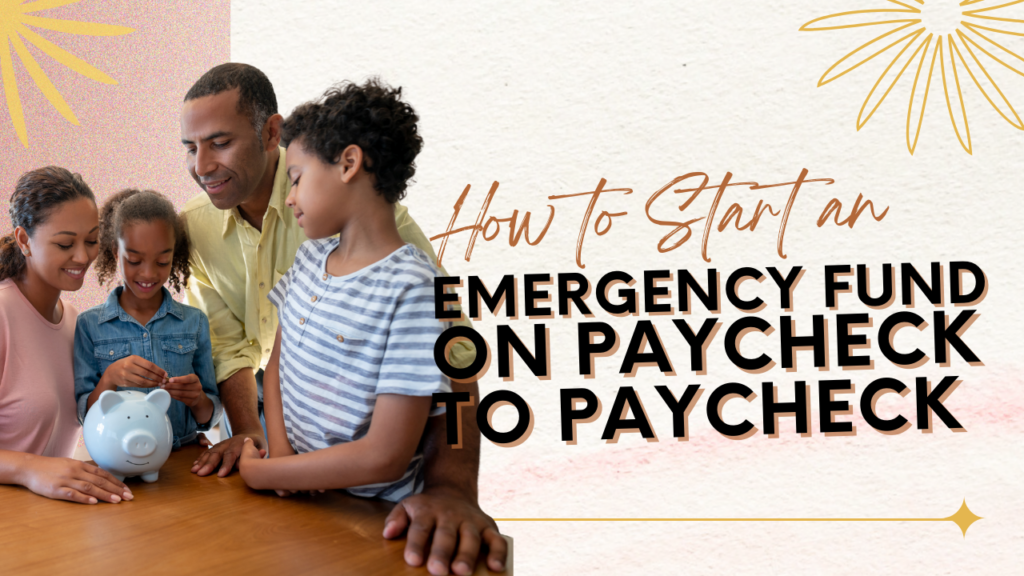Inclusive. Empowering. Supportive.
As moms, our top priority is the well-being of our families. We want our loved ones to feel safe and secure, both emotionally and financially. One crucial step towards achieving that financial security is building a strong emergency fund. In this article, we’ll walk you through what an emergency fund is, why you need it, how much you need in it, and most importantly, how to build it.
What is an Emergency Fund?
An emergency fund is like a safety net for your family’s financial stability. It’s a dedicated pool of money set aside for unexpected expenses or emergencies that may arise.
Whether it’s a sudden medical bill, a car repair, or even a job loss, having an emergency fund provides you with a sense of security and peace of mind knowing that you’re prepared for whatever life throws your way.
Why Do You Need a Strong Emergency Fund?
Life is full of uncertainties, and emergencies can happen when we least expect them. Without an emergency fund, you might find yourself relying on credit cards, loans, or borrowing from friends and family to cover any unplanned expense. This can quickly lead to debt, stress, and a loss of control over your finances.
However, with a well-funded emergency fund, you can confidently navigate these unexpected situations without feeling overwhelmed by financial strain. Having that cushion of funds allows you to handle emergencies promptly, maintain financial stability, and protect your family from potential hardships.
How Much Do You Need in Your Emergency Funds?
Determining how much to save money in your emergency fund depends on various factors, such as your family size, monthly expenses, and personal circumstances. A general guideline is to have enough to cover three to six months’ worth of expenses. Having enough for six months of expenses gives you ample space if you encounter an unexpected expense. Just be sure not to put too much: “An emergency fund is designed to cover only the necessary monthly expenses (read: keep the lights on, not maintain your gym membership).” Putting too much into an emergency fund could mean losing money due to inflation — especially if any excess could have been put into investments.
Start by calculating your essential monthly household expenses, including rent or mortgage payments, utilities, groceries, insurance premiums, and debt payments. Multiply that amount by the number of months you want your emergency fund to cover. This will give you a target savings goal to work towards.
Keep in mind that every family’s situation is unique, and your ideal emergency fund may be more or less than the suggested range. Consider factors like job stability, health, and any additional financial responsibilities when determining the appropriate amount for your family.
How Do You Build an Emergency Fund?
Building an emergency fund requires discipline, commitment, and a solid plan. And there’s never a bad time to start preparing an emergency fund. “…Emergencies such as sudden illness or disability, major car repairs or a new roof, can be expensive, and there’s never a good time for these things to happen,” according to Pamela Rodriguez of Investopedia. Here are some practical steps to help you get started:
1. Set a Goal
Determine how much money you want to save and set a specific target date to achieve it. Having a clear goal will help you stay motivated throughout the saving process. You can also determine what you will put in your fund. Will it include extra cash, tax refund, or other things? Even any small amount will help build your rainy day fund.
2. Create a Budget
Evaluate your current expenses and identify cash flow areas where you can cut back. Look for opportunities to reduce discretionary spending and redirect those funds toward your emergency fund. Every dollar saved brings you closer to your financial security.
3. Automate Your Savings
Make saving effortless by setting up automatic direct deposit transfers from your paycheck or checking account into a separate savings account designated for emergencies. This way, you won’t even have to think about it, and your emergency fund will grow steadily over time.
4. Minimize Debt
Prioritize paying off high-interest debts, such as credit card debts or personal loans. Reducing your debt burden will not only free up more money for your emergency fund but also improve your overall financial health. You can work with your creditors, such as credit card companies to find the best way to settle your credit card balance, for example. You also want to avoid high-interest loans.
5. Stay Focused
Building an emergency fund takes time and dedication. It’s essential to stay focused on your long-term financial goals, reminding yourself of the peace of mind and security that your emergency fund will provide.
Building an emergency fund is an ongoing process. Make sure to celebrate milestones along the way and keep adjusting your savings strategy as your circumstances change.
Where Should You Keep Your Emergency Fund?
Once you’ve started building your emergency fund, it’s important to keep it in a safe and accessible place. Here are a few options to consider regarding where to put the money:
- High-Yield Savings Account: Look for a savings account that offers a higher interest rate than a traditional savings bank account. These accounts typically have fewer fees and can help your emergency fund grow over time. Sabrina Karl of Investopedia puts the ideal interest rates of HYSAs to be over 5%: “Drawn from our daily rate research on about 100 banks and credit unions that offer nationwide high-yield savings accounts, even the 10th-best rate on the list pays 5.25% APY.”
- Money Market Account: Similar to a savings account, a money market account offers a higher interest rate while still providing easy access to your funds. It’s a low-risk option that allows you to earn some interest on your emergency savings.
- Certificates of Deposit (CDs): If you want to earn a higher interest rate and don’t need immediate access to your emergency fund, consider investing in a certificate of deposit. CDs are time deposits with fixed terms (ranging from a few months to several years) and often offer higher interest rates than regular savings accounts.
The key is to strike a balance between accessibility and earning potential. Choose an option that aligns with your financial goals and personal circumstances.
When Should You Use Your Emergency Fund?
It’s important to have a clear understanding of when it’s appropriate to dip into your emergency fund. Here are a few guidelines:
- True Emergencies: Reserve your emergency fund for genuine emergencies that threaten your financial stability. These could include unexpected medical expenses, major car repairs, or sudden job loss. By having this fund in place, you can handle these situations without resorting to debt or other financial hardships.
- Temporary Financial Setbacks: While it can be tempting to use your emergency fund for non-essential expenses or temporary setbacks, it’s important to use it wisely. Evaluate whether the expense truly qualifies as an emergency and consider alternative strategies, such as adjusting your budget or finding additional income sources, before tapping into your fund.
- Rebuilding After Use: If you do need to use your emergency fund, make it a priority to rebuild it as soon as possible. Set a plan in motion to replenish the funds that were used, ensuring that you maintain your financial security for future unforeseen circumstances.
Every situation is unique, and ultimately, the decision on when to use your emergency fund rests with you and your family. Trust your instincts, use your funds responsibly, and continue to make the well-being of your family your top priority.
Keeping your emergency fund in a safe and accessible place and using it judiciously during true emergencies helps you take proactive steps toward securing your financial well-being.
Remember, your emergency fund is a powerful tool that provides peace of mind and enables you to navigate unplanned expenses with confidence. Stay focused, adjust your savings strategy as needed, and embrace the empowering journey of building and utilizing your emergency fund.
To Wrap Up
By taking the necessary steps to build a strong emergency fund, you are empowering yourself and your family with financial security. With an inclusive and supportive mindset, you can create a happy, thriving, and abundant future for your loved ones. Start today, and watch your emergency fund grow, bringing you closer to the peace of mind you deserve. It’s never too late to start saving for your family and personal finance health!











